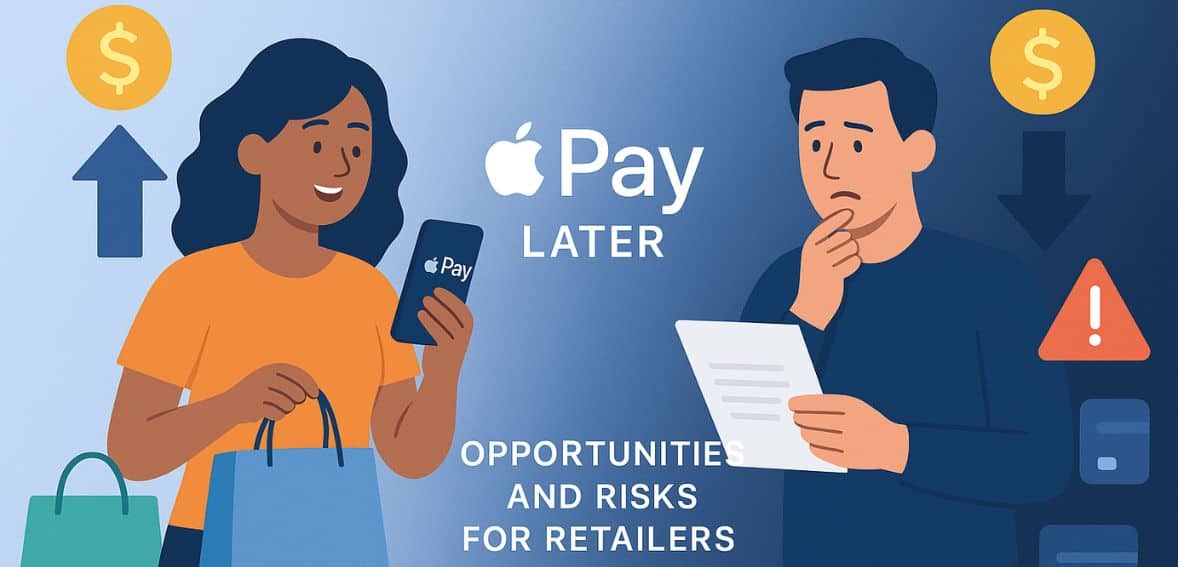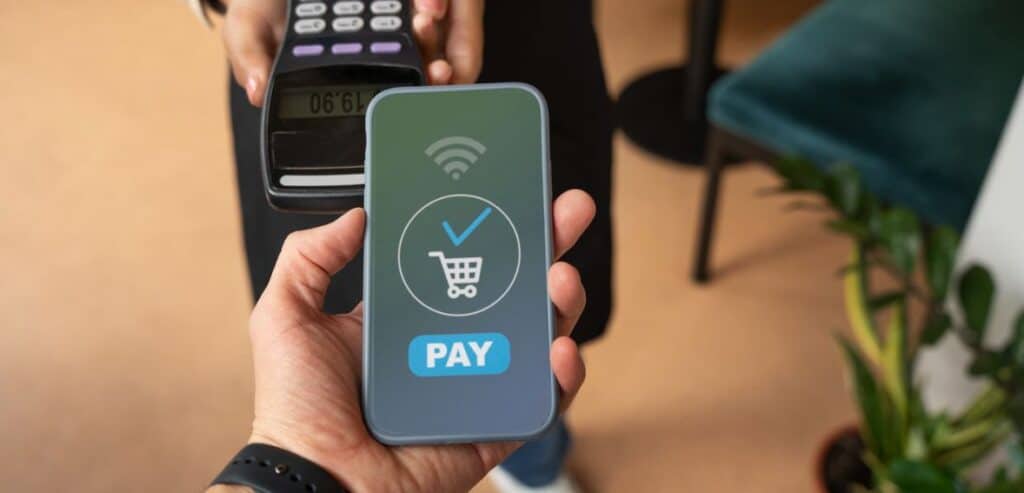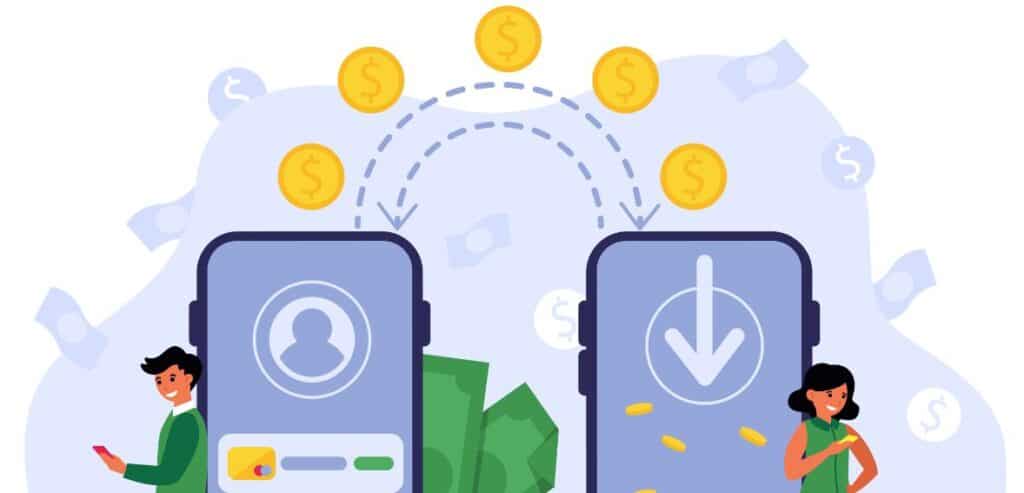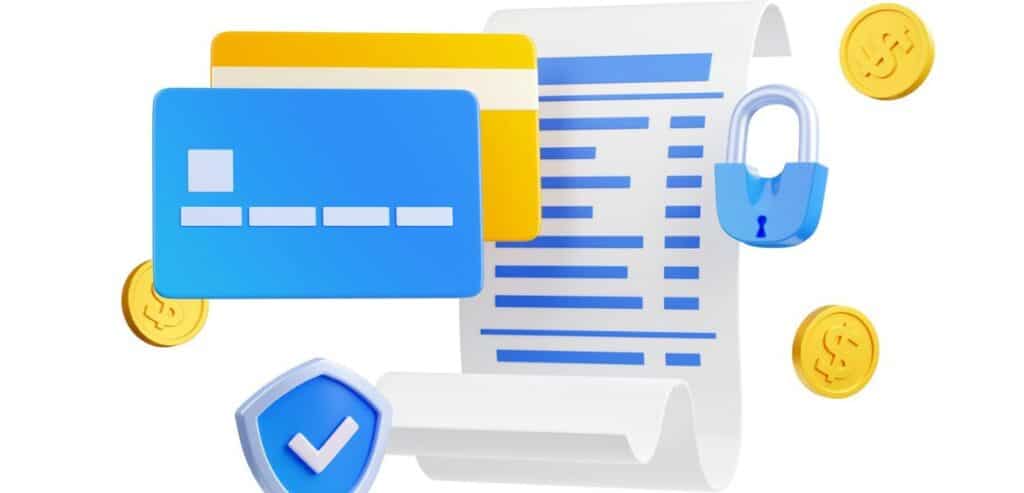
By alphacardprocess September 23, 2025
Pay Later and Buy Now (BNPL) solutions, such as Apple Pay Later, are transforming how consumers shop by offering flexible and convenient payment options. One of the most disruptive developments in commerce in recent years is Buy Now, Pay Later (BNPL), which has changed consumers’ perceptions of flexibility and affordability.
Only Apple’s ecosystem could provide the polish and trust that Apple Pay Later brought to the BNPL model, propelling it into the mainstream. This is an unquestionably good time for retailers. However, there are serious risks associated with possible increases in sales and customer loyalty, such as margin pressure and regulatory uncertainty. Retailers getting ready to sell have to understand both sides of this equation.
What BNPL and Apple Pay Later Mean for Retailers

The idea behind Buy Now, Pay Later is simple: customers make purchases up front and spread out their payments over several weeks or months, frequently without incurring interest. Even though businesses like Klarna, Afterpay, and Affirm made this model more widely known, Apple’s arrival drastically alters the market.
Apple Pay Later, in contrast to third-party apps, is integrated into Apple Pay and linked to devices that millions of people already use for safe transactions. With the support of one of the most powerful consumer brands in the world, this integration guarantees retailers a smooth checkout process.
Apple Pay Later builds directly on existing Apple Pay infrastructure, making it easier for customers to split payments without leaving the checkout experience. For retailers, ensuring smooth Apple Pay integration is key to unlocking the benefits of this service and maintaining customer trust.
The intricacies of BNPL as a whole, such as customer overextension, compliance issues, and the effect on merchant margins, are also passed down to Apple Pay Later. Before determining how fully to adopt BNPL options, retailers must balance these systemic issues against Apple’s reach and credibility.
Evolution of Pay Later and Buy Now and Apple Pay Later
From specialized fintech products, BNPL has expanded into widely used payment systems. BNPL was first made widely known online by sites like Klarna, Afterpay, and Affirm. Since then, it has spread to mobile wallets and integrated solutions like Apple Pay Later.
Customers’ purchasing power is increased by the model’s flexibility, which comes free of high fees or interest. In order to satisfy customer demands for easy, quick, and flexible payments, retailers have adopted BNPL. Retailers are now able to provide consistent experiences across channels because of to the evolution of BNPL from purely online applications to in-store integration. Because of this development, modern retailers must comprehend BNPL.
Opportunities for Retailers
Driving Higher Conversions and Sales

It has been repeatedly demonstrated that BNPL increases conversion rates and decreases cart abandonment, particularly for more expensive items. Customers may feel more at ease dividing payments into smaller installments if they are hesitant to spend $300. By eliminating friction, Apple Pay Later enhances this effect.
There is no need for extra apps or drawn-out approval processes because the payment option appears in the same flow as Apple Pay. This makes it easier for retailers to move customers from browsing to purchasing. When customers add more items, knowing they can spread out payments, Apple Pay Later raises average order values and increases the chance of a sale by lowering upfront barriers.
Expanding Reach to Younger and Credit-Averse Consumers
Younger generations are increasingly avoiding traditional credit cards, which were once the standard way to finance purchases, because they are concerned about interest rates and long-term debt. Payment methods that feel more flexible and transparent are preferred by Gen Z and millennials in particular.
By presenting itself as a cutting-edge, interest-free substitute, BNPL closes this gap. By integrating BNPL into a well-known ecosystem, Apple Pay Later increases the appeal. Offering Apple Pay Later to younger consumers shows that a retailer is in line with the payment habits of their core customer base of the future. In a market where innovation is expected, this adoption not only increases brand relevance but also promotes the acquisition of new customers.
Enhancing Customer Loyalty and Repeat Purchases
The capacity of BNPL programs to foster repeat customer habits is one of their less evident but still important advantages. Customers who successfully work out installment plans with a retailer are more likely to make repeat purchases because they trust that the payment option will be affordable.
This stickiness is increased by Apple Pay Later’s smooth integration with Apple Wallet. Consumers don’t have to manage accounts on several platforms, download a new app, or remember login credentials.
This integrated loyalty loop, where convenience and familiarity boost the likelihood of repeat business, is advantageous to retailers who use Apple Pay Later. Simpleness and affordability together have the power to convert infrequent buyers into loyal patrons over time.
Standing Out in Competitive Markets
In crowded retail settings, differentiation is essential. When every brand sells similar products, little things like flexible payment options can make all the difference in a buyer’s choice. Early adoption of Apple Pay Later by retailers conveys to consumers that this is a company that values choice, convenience, and innovation.
The availability of Apple Pay Later can be a subtle yet effective competitive advantage in markets where Apple Pay is already widely used, such as electronics, fashion, and beauty. Retailers have the chance to signal modernity in a way that fosters trust and draws in forward-thinking customers, in addition to meeting consumer expectations.
How Apple Pay Later Works
Apple Pay Later is a native BNPL solution that is integrated into the Apple Wallet ecosystem. Consumers who pay on time can divide purchases into four equal payments spread out over six weeks, with no interest or late fees. Instant approval is granted based on Apple’s risk assessment, enabling a seamless online and in-store checkout process.
Because the transaction looks like a typical Apple Pay purchase, retailers benefit from seamless integration, which makes payment reconciliation easier. Because Apple manages risk and underwriting, merchants have less administrative work to do.
Retailers need to be aware of the operational and financial ramifications of the system, including possible effects on chargebacks, returns, and reconciliation procedures, even though it can increase conversion and draw in Apple users.
Revenue and Conversion Benefits

BNPL and Apple Pay Later can drive significant revenue growth. By offering flexible payments, retailers lower the psychological barrier to higher-ticket purchases, often increasing average order values.
Consumers who might hesitate to pay full price upfront may now complete purchases, boosting both conversion and basket size. Seasonal sales, high-end electronics, and luxury goods are particularly well-suited for BNPL adoption.
For omnichannel retailers, the integration of Apple Pay Later can provide a consistent experience online and in-store, aligning with consumer preferences for speed, convenience, and transparency. Properly promoted, BNPL can become a strategic tool for attracting new customers.
Balancing Opportunity and Risk
The reality of BNPL, and by extension Apple Pay Later, is that it is neither an unqualified opportunity nor an unmanageable risk. Its value to retailers depends largely on context: the types of products sold, the demographics of the customer base, and the competitive dynamics of the industry.
Retailers selling higher-ticket items in fashion, electronics, or luxury goods may find the sales boost outweighs the higher fees. Meanwhile, lower-margin retailers selling essentials may see little long-term value in adopting installment options. Success lies in careful evaluation, pilot testing, and continuous monitoring. Retailers should view Apple Pay Later not as a silver bullet but as one tool in a broader payment strategy.
Practical Steps for Retailers
Adopting Apple Pay Later or any BNPL solution requires planning. Retailers should start by conducting a financial analysis to understand how BNPL fees will affect margins at different adoption rates. Next, they should identify which customer segments are most likely to use BNPL and evaluate whether those segments align with long-term business goals.
Testing Apple Pay Later in a limited rollout can provide real-world data without committing the entire business to the model. Finally, retailers must integrate BNPL into customer education efforts, ensuring shoppers understand repayment terms and the responsible use of installment options. By approaching BNPL strategically, retailers can maximize the upside while limiting downside risk.
Financial Considerations
While Apple handles underwriting, BNPL adoption still carries financial implications. Retailers may face delayed settlements or potential liability for fraudulent purchases if disputes arise. Depending on the integration, BNPL fees—often a percentage of each transaction—can reduce profit margins.
Merchants must factor in these costs when evaluating pricing strategies and overall financial planning. Mismanaged BNPL programs may appear profitable in the short term but erode margins if fees, returns, or operational inefficiencies accumulate. Understanding cost structures, monitoring performance, and negotiating provider terms are essential for maintaining financial health.
Regulatory Environment

The BNPL industry is under increasing regulatory scrutiny. U.S. and international authorities are examining consumer protections, disclosure requirements, and responsible lending practices. Retailers offering BNPL must ensure compliance with applicable laws, including proper disclosure of payment schedules, fees, and terms.
Apple Pay Later simplifies compliance by managing underwriting, but merchants remain responsible for marketing practices, customer communication, and reporting. Non-compliance can result in fines, reputational damage, and legal exposure. Retailers should stay informed on evolving regulations and integrate compliance checks into their payment and marketing workflows.
Implementation Strategies
Successful BNPL adoption requires careful planning. Retailers must select providers, integrate solutions with point-of-sale systems, and train staff on workflows. Clear communication with customers is essential, including prompts during checkout, transparent terms, and educational resources about installment payments.
Marketing campaigns can highlight BNPL as a convenience, while backend systems ensure accurate reconciliation and reporting. Retailers should also analyze historical sales data to identify categories most likely to benefit from BNPL, prioritizing high-ticket items or seasonal promotions. Strategic rollout mitigates operational risk and maximizes return on investment.
Marketing and Customer Communication

Communicating BNPL options effectively enhances adoption. Retailers should display Apple Pay Later and other BNPL options prominently online, in emails, and at physical checkout points. Messaging should emphasize flexibility, interest-free payments, and simplicity.
Transparency about fees and schedules builds trust and reduces confusion. Educating staff to guide customers on BNPL benefits further increases usage. By aligning marketing efforts with consumer preferences, retailers can maximize BNPL’s impact on sales, loyalty, and overall customer satisfaction.
Performance Monitoring
Monitoring BNPL performance is critical. Retailers should track metrics such as conversion rates, average order value, repeat purchases, and fee impact on margins. Data analytics allows for informed adjustments to marketing, product selection, and checkout flows.
Comparing BNPL performance against traditional credit card payments highlights the value proposition for both customers and the business. Regular reviews enable retailers to optimize strategy, balance costs, and ensure that BNPL programs contribute positively to revenue growth.
Targeting the Right Demographics
BNPL is particularly appealing to younger, tech-savvy consumers who prioritize convenience and cash flow flexibility. Retailers should segment marketing campaigns, emphasizing BNPL for demographics most likely to use it. Data-driven approaches, personalized messaging, and tailored offers increase adoption and loyalty.
Segment-focused strategies allow retailers to allocate resources efficiently, ensuring that BNPL adoption enhances overall profitability rather than creating uniform, untargeted programs.
Staff Training
Retail staff must understand BNPL mechanics, customer communication practices, and troubleshooting processes. Training ensures they can guide customers through installment options, answer questions about payment schedules, and address disputes efficiently.
Properly trained teams reduce friction, improve conversion rates, and enhance customer confidence. Retailers should incorporate BNPL processes into standard workflows to maintain consistency and reliability across touchpoints.
Fraud Prevention
BNPL programs can introduce new fraud risks, particularly in online transactions. Retailers must employ verification measures, monitor for suspicious activity, and work closely with providers like Apple Pay Later to manage risk. Leveraging provider-backed fraud prevention tools reduces exposure while maintaining seamless customer experiences. Periodic audits and fraud monitoring are critical for sustaining trust and protecting revenue.
Multi-Channel Considerations
Retailers operating across borders or multiple channels must consider BNPL compatibility, settlement timing, and currency conversions. Apple Pay Later is primarily U.S.-focused, but international strategies may require alternative providers.
Unified experiences across online and offline channels are critical for brand consistency and customer satisfaction. Proper planning ensures operational efficiency and minimizes complications across multiple markets.
Evaluating Long-Term Impact
BNPL adoption should be evaluated not only on immediate sales but also on long-term effects on customer behavior, loyalty, and lifetime value. Retailers should track trends over time, assessing whether installment options drive repeat purchases, larger baskets, or improved retention. Data-driven insights allow for strategic adjustments to maximize benefits.
Adapting Marketing and Checkout Strategies
To fully leverage Apple Pay Later and BNPL, retailers should rethink marketing and checkout strategies. Highlighting flexible payment options at the point of sale, during online checkout, and in promotional campaigns can drive higher adoption and increase consumer confidence.
Tailoring messaging to showcase convenience, interest-free payments, and budgeting flexibility helps customers see the tangible benefits of installment options. Retailers should also consider bundling BNPL promotions with seasonal sales or high-ticket items, making these purchases more attainable.
Ensuring staff are trained to explain the process and answer questions reduces friction, builds trust, and reinforces the perception of a modern, customer-centric brand.
Meeting Evolving Customer Expectations
Consumer expectations continue to evolve, with greater demand for flexible, seamless, and secure payment solutions. BNPL, particularly Apple Pay Later, represents a broader shift toward instant, transparent financial experiences.
Retailers that proactively integrate and optimize these offerings position themselves to meet future demands while staying competitive in an increasingly digital retail environment.
Conclusion
Apple Pay Later and BNPL offer significant opportunities for retailers: increased conversions, higher average order values, improved customer loyalty, and alignment with modern consumer expectations. However, these benefits come with operational, financial, and regulatory considerations that cannot be ignored.
Retailers must implement careful planning, staff training, technology integration, risk management, and cost monitoring to maximize success. Hybrid strategies, transparent communication, and continuous analysis allow merchants to harness BNPL’s advantages while mitigating downsides.
When executed thoughtfully, Apple Pay Later becomes more than a payment option—it is a strategic tool to drive growth, strengthen customer relationships, and future-proof retail operations.